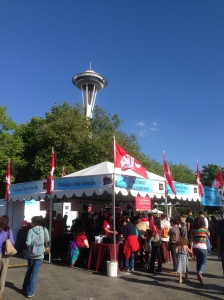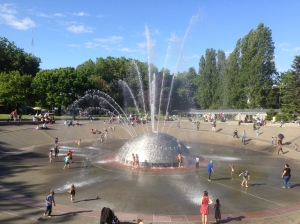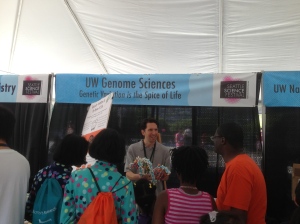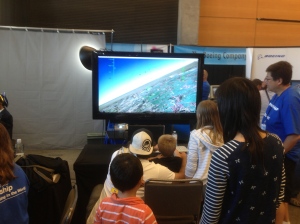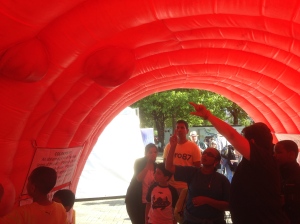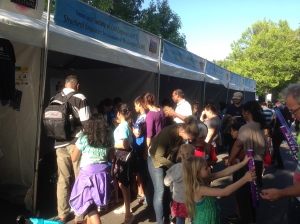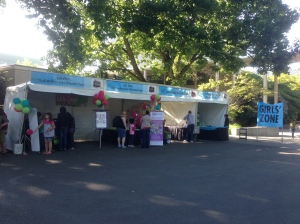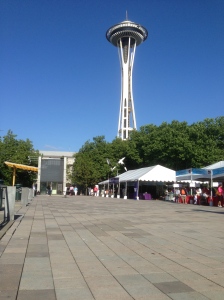Seattle Center is a 74-acre complex of theaters, music halls, parks, sport facilities, museums, and restaurants tucked neatly within Seattle’s Lower Queen Anne neighborhood. The iconic Space Needle, crown jewel of the facility since the 1962 World’s Fair, hugs the compound’s southwest corner. Last June, as part of a celebration of Seattle Center’s fiftieth birthday, the complex hosted the inaugural Seattle Science Festival. Organized by Seattle’s Pacific Science Center and buoyed by financial support from a number of corporations, businesses, and non-profit organizations from the Puget Sound metropolitan area and beyond, the eight-day festival highlighted research and environmental topics relevant to western Washington’s climate, ecology, and booming science and engineering economy. The eight-day festival attracted over 40,000 children and families to more than 100 events across the Puget Sound region.
The 2012 festival was so successful that the Pacific Science Center and other major partners decided the event was worth another go. The second annual Seattle Science Festival began on 6 June and runs through 16 June. While the majority of the 2013 Seattle Science Festival’s events are held in the Emerald City, dozens of events are scheduled for venues across the Puget Sound metropolitan area, as well as western Washington communities on Whidbey Island, the Olympic Peninsula, and the Cascade foothills. Saturday, 8 June saw the festival’s signature event: the Science Expo Day. From 10:00AM to 6:00PM, huge swathes of Seattle Center’s sun-drenched acreage (God bless the dry season) were transformed into roving outdoor science fairs. The event boasted over 150 booths, staffed by volunteers from dozens of Washington State research institutions, private companies, educational institutions, and non-profit organizations.
I managed to make it over to Science Expo Day for the last 45 minutes of programming to snap photographs and speak with volunteers and attendees. Even as the evening settled in, the festival’s venue was still packed with families. Every booth buzzed with activity, and many volunteers rushed to and fro to engage eager children and inquisitive parents alike. Admittedly, I usually think so-called “family-oriented” outreach events are directed solely toward children, with parents as a mere afterthought. Yet in nearly every booth, I encountered adults asking as many (if not more) questions than their charges.
Expo Day’s participating organizations included many of the major players in Washington’s science community. The University of Washington staffed no less than fifteen booths, while Washington State University held at least twelve. Other major attendants included the Fred Hutchinson Cancer Research Center, the Pacific Science Center, and Seattle University. There was a substantial queue to enter Seattle Children’s Hospital’s “Science Adventure Lab” (in a spiffy RV).
The Boeing Company’s booths sported smart, joystick-controlled flight simulators. Engineering societies and museums offered demonstrations in robotics and surprisingly popular math activities, while budding biology nerds ran wild among the interactive exhibits offered by the Seattle Aquarium, the Woodland Park Zoo, and the University of Puget Sound. Government entities elbowed their way in as well, including the Seattle-based office for the National Oceanic and Atmospheric Administration (NOAA) and the Washington Department for Ecology.
Within the Fred Hutchinson Cancer Research Center’s giant, inflatable colon, toddlers punched basketball-sized representations of polyps while their parents quizzed volunteers on the early signs of colon cancer.
Stage performances, coupled with music piping in from the nearby Pagdiriwang Philippine Festival, provided a celebratory energy. In most cases, festival organizers placed exhibits perfectly to accommodate crowd overflow (which was especially needed near the Pacific Science Center’s robotics demonstrations). But, in a few places, I worried that exhibits were placed too far from the buzz of the festival’s central hub.
Treading across one particularly anemic capillary near the opera house, I was distressed to find the “Girls’ Zone” for science and technology virtually abandoned. Volunteers for the National Girls Collaborative Project and the Girl Scouts of America reassured me that they had indeed seen an “overwhelming” amount of foot traffic throughout the day, and that the emptiness I witnessed was simply a by-product of the late hour. They were not sure why they had been placed so far from the festival’s hub (where crowds were still gathering), but some speculated that they were given extra space (including a large lawn) in case they opted to conduct “large, spread-out demonstrations” (which they did not). I passed other far-flung booths near the basketball arena, including one for Geocoaching, Seattle’s Fremont-based GPS cache hunt organization. In all cases, booth volunteers reassured me they’d received “great” foot traffic despite their remote location; but they were also occasionally puzzled by the generous and ultimately unnecessary amount of space.
After reaching the festival’s core, I could not help but notice a large tract of free land by the Space Needle, near prominent exhibits for the University of Washington, Seattle University, and NOAA.
This space could have accommodated the “Girls’ Zone” three times over. I hope that future iterations of the Seattle Science Festival opt for a more compact formation to ensure that no organization faces a fall-off in foot traffic or the even perception of isolation. An event of this magnitude will always have its periphery. Still, to avoid even a hint of insensitivity, next year I would place the “Girls’ Zone” next to Boeing’s flight simulators. After all, according to the National Science Foundation, as recently as 2010 less than one-quarter of Engineering Ph.D. degrees were awarded to women. Obviously, we have some catching up to do.
Full Disclosure: I am a former employee of the Fred Hutchinson Cancer Research Center, a former student of both the University of Washington and the Fred Hutchinson Cancer Research Center, and a current employee of the University of Washington.

